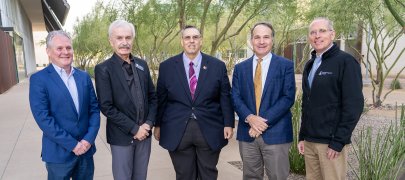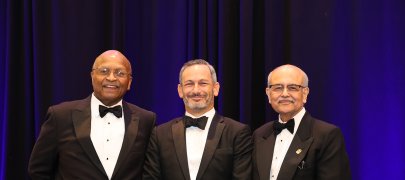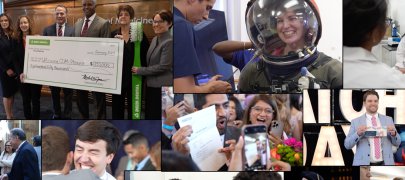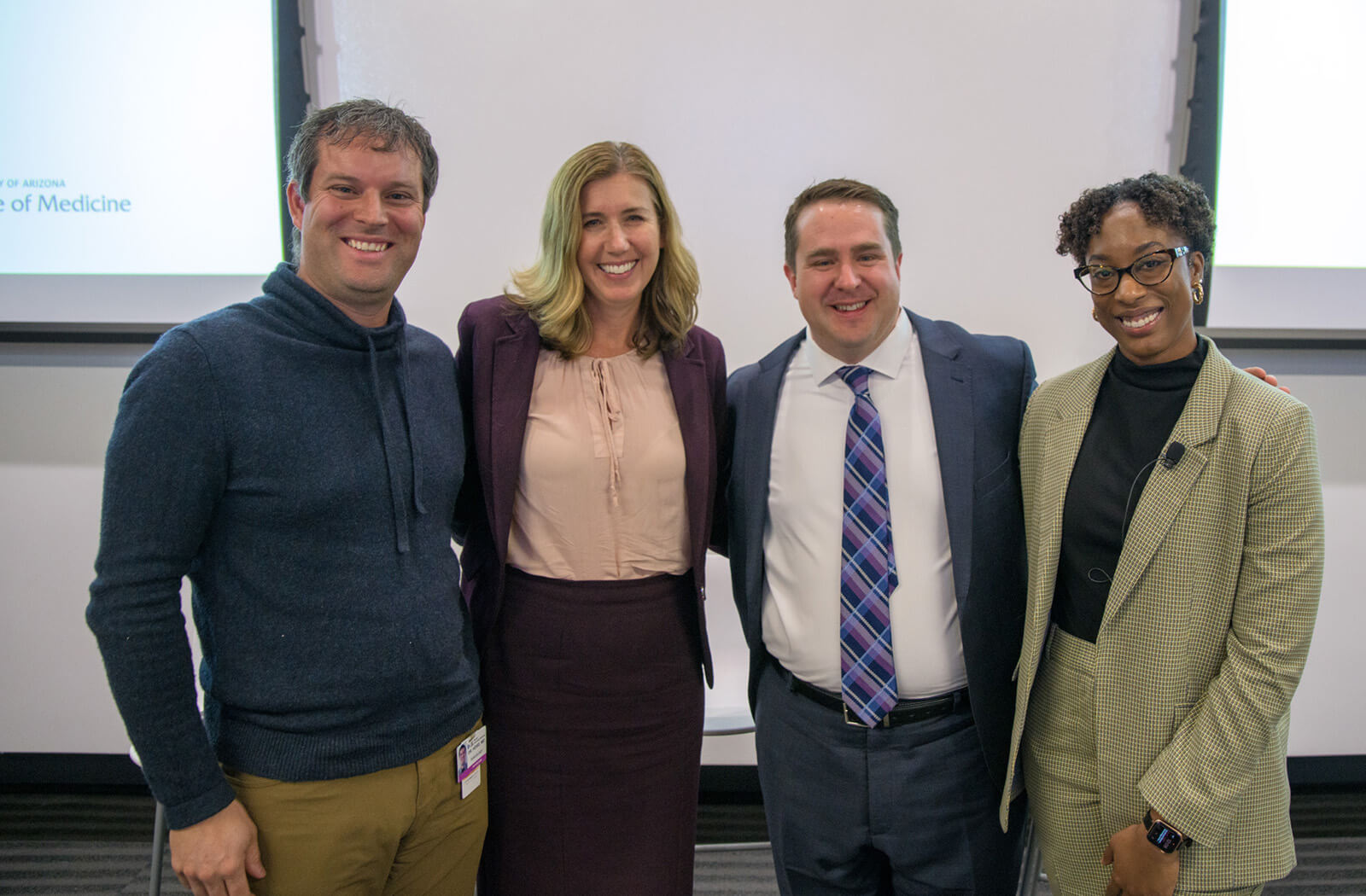
Innovate Medicine Alumni Summit Highlights Advancements in Health Care

The inaugural Innovate Medicine Alumni Summit welcomed alumni back to learn how their peers and college faculty are leading advancements in medicine. The summit, held December 10, featured alumni and leaders in cybersecurity, clinical care, translational research and academia as part of the celebration of the University of Arizona College of Medicine – Phoenix’s 10th Anniversary of Accreditation.
The college has trained nearly 700 exceptional physicians since welcoming the first class of 24 medical students in 2007.
“We have now begun to see our alumni rise up, not only complete medical school, but begin to complete their residencies and start to move on in their careers,” said Dean Guy Reed, MD, MS, during the event. “So it's really important that we begin to connect to our alumni as they do those extraordinary things.”
The Future of Medical Device Security
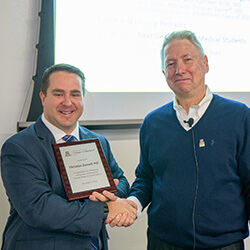
“The future of health care cybersecurity training is not HIPAA,” Dr. Dameff said. Certainly, there will be elements of HIPAA there, as protecting patient information is a physician’s obligation, but more so, “It’s about patient safety. How do we teach clinicians to recognize their dependence on technology and to have workarounds that take care of patients when that technology is no longer there?”
Dr. Dameff serves as an assistant professor of Emergency Medicine, Biomedical Informatics and Computer Science at University of California San Diego. He was also hired as the nation's first medical director of Cybersecurity at UC San Diego Health.
Modern medicine is critically dependent on connected technology, making hospital systems attractive targets for malware and malicious hackers. The prospect may seem farfetched to some, but it has happened recently. There was the 2014 cyber attack on Boston Children’s Hospital, the 2017 “WannaCry” malware that sent the National Health Service in the United Kingdom into disarray and in 2021, an infant died when malware remotely disabled a hospital’s fetal monitoring system.
With the trust and reliance on technology only growing, the potential for failure should a hack occur is only exacerbated. So, what can be done?
“Complex health care problems are very hard to fix quickly,” Dr. Dameff said. But, “There is some good news. This is catching the attention of policymakers, regulators … the Joint Commission is going to get in this game too. And I think what we're going to see over the next 5 – 10 years is a pretty significant regulatory environment change around [cyber] health care.”
Dr. Dameff is helping to change the national conversation on cybersecurity in health care. In July 2021, he presented Stopping Digital Thieves: The Growing Threat of Ransomware before the U.S. House of Representatives. “Health care is critical infrastructure; we, as a nation, should prioritize its security.”
Cardioneural Ablation: A Frontier for New Innovation
Roderick Tung, MD, division chief of Cardiology is at the forefront of cardiovascular medical discovery. “The reason I’m in academic medicine is not to only practice medicine, but to try to change the practice of medicine,” he said.
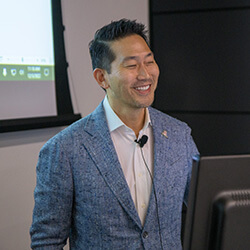
Neurocardiogenic syncope causes the heart rate and blood pressure to drop suddenly, reducing blood flow to the brain resulting in fainting spells. These can be triggered by intense emotion, extreme heat or dehydration, or even a long period of standing.
Dr. Tung performed the procedure on a compassiomate basis for a patient who contacted him. The procedure was successful, and he published the results. That, in turn, enabled him to help more patients who were in search of answers.
“This is the value of academic medicine. When you publish something, publishing is publicity. And that’s a good thing for academic medical centers,” Dr. Tung said. From there, Dr. Tung pooled together other examples of physicians performing the procedure and presented the findings at a session for the Heart Rhythm Society in 2021.
“We looked at 76 procdures, done at 13 academic hospitals in 71 patients … and at a median 8.5 months, 82 percent of patients are free from syncope,” he explained. They also found that the risk of the procedures was less than one percent.
Dr. Tung also serves as a professor of Medicine, as well as director of Cardiovascular Clinical Research for the college and Banner – University Medical Center Phoenix. The team at Banner – University Medical Center Phoenix is leading the nation in this procedure.
Anti-Racism Transformation in Medicine
In 2021, The College of Medicine – Phoenix was selected as one of 11 medical schools across the U.S. and Canada to participate in the Anti-Racist Transformation in Medical Education (ARTinMedEd) initiative, a three-year initiative to dismantle institutional racism.
The Office of Equity, Diversity and Inclusion (OEDI) is requesting members of the campus community to join them in instituting positive change as Phase 3 of the initiative. “We put a call out to our broader institution and said, ‘We need to create what we’re calling a guiding coalition,’” said Francisco Lucio, JD, associate dean of OEDI.
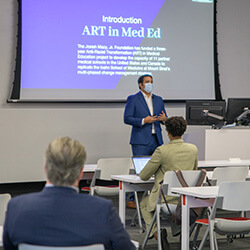
According to a 2018 study, $93 billion in excess health care costs were produced as a result of racial disparities. That resulted in $42 billion in lost productivity per year.
The economics of it are jarring, but in terms of health, the figures are just as scary. “We see life expectancies that are lower for individuals who are racially and ethnically minoritized,” Dean Lucio said. For example, the life expectancy for White individuals is six years longer than Black individuals — 78 versus 72.
Several studies currently available present significant data to support how racism in medicine adversely effects the underrepresented. Camellia Bellis, MEd, education and training specialist for OEDI, shared how the college is tailoring its curriculum to better educate the next generation of physicians on these disparities.
“Along with the AAMC and other medical schools, we have introduced what is called ‘race-conscious medicine,’” Bellis said. This differs from the traditional race-based medicine, where race is ill-defined and inferred to have biological significance, because it centers the focus on how race is often used as a social and power construct.
“Teaching and practicing medicine in this alternative approach, patients are provided support to overcome some of those structural barriers to health; and students are taught the consequences of racism on health with the goal of reducing racial health inequities,” she added.
Bellis, along with Dean Lucio, leads the Health Equity Theme for the college. The health equity curriculum, layered through students’ four years of study, aims to prepare them to recognize and address systemic and structural impediments to care.
Engineering Better Medicine
Ben Conner’s research for his PhD focused on resistive robotic gait training to restore neuromuscular function in children suffering from cerebral palsy (CP), a pediatric onset movement disorder caused by injuries to the brain during development.
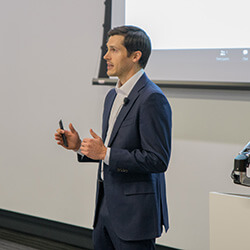
“The majority of individuals will have progression of their symptoms into adulthood,” Conner said. This leaves them significantly weaker than their peers, leading to gait dysfunction, further inactivity and, more than likely, worse health outcomes.
Current therapies, including strength training/physical therapy, ankle and foot orthoses, orthopedic surgery, or expensive assistive training devices offer potential solutions. But the results do not seem to address the root of the mobility problems or provide longlasting outcomes. Conner’s robotic device sought to strengthen the muscles to alleviate the limits of coordination.
“We thought, if instead of doing assistive robotic grait training, we did resistive robotic gait training, where we forced the user to engage with the device, we might see different results,” Conner said. So, they took a previously developed exoskeleton — consisting of a control and actuation assembly, bi-lateral ankle assemblies, motors, carbon fiber foot plates, movement sensors and a Bluetooth control — to create reactionary resistance based upon the wearer’s steps.
Conner hypothesized that with the robotic device, the wearer’s gait would improve over time, and their overall strength would improve, as well. This would lead to their ability to handle increased resistance and avoid the musculatory atrophe that someone with CP would generally experience.
This was tested extensively in a number of sessions, measuring initial measurements against post-training results. The children they tested saw increased ankle strength after only 10 training sessions, discernible improvement in neuromuscular control at the ankle and a significant boost in energetic efficiency. Tests of their mobility also showed major progress. The study led to an R01 Grant and is now being used in a randomized controlled trial (RCT).
“It’s a multi-site, RCT through different children’s hospitals, and it’s being run, right now, by my previous PhD lab,” Conner said. “The idea is that eventually we would end up with an intervention that could specifically address muscle weakness and deficits in coordination that would help solve gait dysfunction in this population and allow these kids to be more physically active, more mobile and have increased survival. There’s a lot of exciting work ahead.”
Conner finished his PhD in Clinical Translational Sciences in 2021. He will graduate from medical school with the Class of 2024.
Where Humanism Meets Technology
The summit closed with a dynamic panel discussion, titled Where Humanism Meets Technology in Medicine, moderated by Shannon Alsobrooks, Class of 2025, with panelists Kathleen Brite, MD, Will Heise, MD, and Dr. Dameff.
When asked, “How has technology changed the way patients interact with their doctors,” the trio outlined both pros and cons.
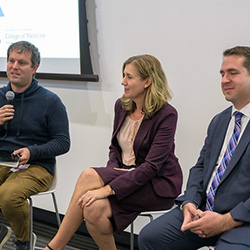
Technology has also enabled physicians greater flexibility to engage with their patients. “We have patients who are scattered throughout the state, or around the country, who we can now interact with easily,” said Dr. Heise.
Despite those benefits, the panel also noted some of the drawbacks the age of information carries, specifically patient portals and the unease they can create with patients who jump to conclusions prior to consulting their doctor.
A follow up question expanded on this idea, linking it to medical education and how the college could potentially utilizie technology in its Doctoring course to better prepare students for future clinical rotations.
Dr. Heise took the lead, stressing the importance of a student being able to learn with the same equipment that they will later utilize in their careers. “In our education, in particular as we talk about how you interact one-on-one with patients, it’s necessary that we train in such a way that that kind of technology is present,” he said.
The way a doctor is able to manage working on a laptop, while also being present with their patient is a learned behavior. The only way to perfect the balance between the two takes repetition.
With any upgrade or advancement, though, it is ultimately up to the physician on how best to incorporate it into their practice. “The key to the technology is not to let technologists tell you how it would be useful in medicine when they don’t know how to take care of patients,” said Dr. Dameff. And he knows from experience. As a medical student, he and a classmate were early adopters of Google Glass, a now defunct piece of hardware.
Google Glass didn’t ultimately last as a viable tool, but for Doctoring, they were able to use it to see how patients would react to receiving bad news. In essence, with Glass, they looked through the eyes of the patient and reflected upon how they conveyed that diagnosis. “It was a cool application of that technology, and it was driven by clinicians who understood what it really meant to practice medicine,” he said.
The wide-ranging discussion further delved into how aritificial intelligence (AI) has optimized the accuracy and expediency of the information physicians receive. The benefits of AI are vast, but do they come at a cost? Do observational skills of physicians suffer when their expertise is not as relied upon? Will AI replace the traditional doctor/patient interaction?
Dr. Brite was sure to note the value of having patients’ preliminary information fulfilled prior to meeting the patient. “When AI can help bring me toward my probable differential diagnosis, then I can have that meaningful interaction and time with my patients,” she said.
Dr. Brite did not agree that the role of a physician was losing its relevance in patient care with the widespread adoption of AI. “I’ve never felt in danger of being replaced because, I think, there are just certain things a computer will never do,” she said.
As an example, she noted the relationship physicians build with their patients over time. That intimacy enables them to read how someone may be feeling on a given day. “If my patient that I know is normally upbeat, bubbly, has flat affect when they come to see me on one of my visits, I will be in tune with that, where a computer won’t,” she explained. It was a sentiment they all shared.
Over the course of the discussion the intrinsic value of technology in health care was readily apparent and acknowledged. But the panelists agreed that health care centered in humanism and supported by advanced technology is most beneficial to patient outcomes.
Dr. Brite is the associate dean of Clinical and Competency-Based Education at the college, and Dr. Heise serves as an an assistant professor in the Division of Clinical Data Analytics and Decision Support.
About the College
Founded in 2007, the University of Arizona College of Medicine – Phoenix inspires and trains exemplary physicians, scientists and leaders to optimize health and health care in Arizona and beyond. By cultivating collaborative research locally and globally, the college accelerates discovery in a number of critical areas — including cancer, stroke, traumatic brain injury and cardiovascular disease. Championed as a student-centric campus, the college has graduated more than 900 physicians, all of whom received exceptional training from nine clinical partners and more than 2,700 diverse faculty members. As the anchor to the Phoenix Bioscience Core, which is projected to have an economic impact of $3.1 billion by 2025, the college prides itself on engaging with the community, fostering education, inclusion, access and advocacy.
